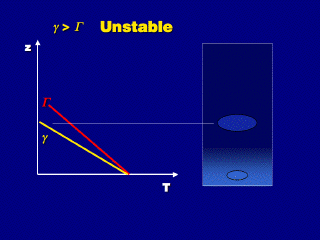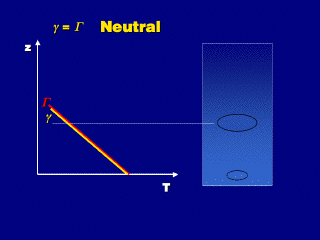The formation of clouds by simple
convection requires air parcels to rise due to their positive buoyancy. This
requires the rising air parcel to be warmer than the surrounding environmental
air. The air parcel can be in this state either by
- being diabatically heated (for
example, by conduction from being in contact with the sunlight-heated ground);
- not losing temperature as quickly
as the environment as altitude increases and the air parcel expands adiabatically.
The second case will be examined
here, because it also has an effect on how parcels rise in the first case. What
we need to look at is the difference between the lapse rate for air parcels
(adiabatic lapse rate, either dry or moist) and the lapse rate for the environment.
The relationship between the two lapse rates (less than, greater than, or equal)
will characterize the stability
of the atmosphere (stable, unstable, neutral), while the difference between
the air parcel temperature and the temperature of the surrounding air (less
than, greater than, or equal) will characterize the buoyancy
of the air parcel (negative, positive, or neutral buoyancy). The atmosphere's
stability will then control the motion of air parcels by affecting the air parcel
buoyancy, and therefore the shapes of clouds formed if condensation of cloud
droplets occurs.
 In the stable atmosphere case, an air parcel loses temperature faster
than the environment as the air parcel rises. This means the air parcel, if
it started out warmer than the environment, will quickly become the same temperature
or cooler than the environment as the parcel and environmental temperatures
converge.
In the stable atmosphere case, an air parcel loses temperature faster
than the environment as the air parcel rises. This means the air parcel, if
it started out warmer than the environment, will quickly become the same temperature
or cooler than the environment as the parcel and environmental temperatures
converge.
If the air parcel started at the
same temperature as the environment (so it is in a state of equilibrium, as
shown in the diagram), nudging it upward would cause its temperature to become
lower than the surrounding air temperature, since the air parcel loses temperature
faster than the surrounding air in this particular situation. The air parcel
sinks back down to its original position, since air parcels that are cooler
than the environment will sink. This resembles stable
equilibrium.
When the atmosphere is stable,
vertical motion of air parcels is suppressed (buoyant air parcels will rise
for a while then stop when its temperature equals the environmental temperature
at the neutral buoyancy altitude).
 In the unstable atmosphere case, we have the opposite relationship
between the adiabatic lapse rate and the environmental lapse rate as we had
with the stable atmosphere. Now, adiabatically expanding and rising air parcels
lose temperature more slowly than the surrounding air, so the air parcels will
tend to be warmer than the environment when they rise (or cooler than the environment
when they sink). Thus, the initial motion of air parcels will be enhanced: rising
air parcels will continue to rise or sinking air parcels will continue to sink.
This resembles the case of unstable equilibrium, where nudging an
unstable system causes it to accelerate away from the original equilibrium configuration.
In the unstable atmosphere case, we have the opposite relationship
between the adiabatic lapse rate and the environmental lapse rate as we had
with the stable atmosphere. Now, adiabatically expanding and rising air parcels
lose temperature more slowly than the surrounding air, so the air parcels will
tend to be warmer than the environment when they rise (or cooler than the environment
when they sink). Thus, the initial motion of air parcels will be enhanced: rising
air parcels will continue to rise or sinking air parcels will continue to sink.
This resembles the case of unstable equilibrium, where nudging an
unstable system causes it to accelerate away from the original equilibrium configuration.
 In a neutral atmosphere, the environmental and adiabatic lapse rates
are equal, so air parcels and the environment change temperature at the same
rates and their temperatures will always be the same (if their initial temperatures
were equal). The air parcel will always be in neutral buoyancy, and will neither
rise by itself nor sink back down if nudged upward. This resembles a case of
neutral equilibrium, where perturbing
the equilibrium system causes a new equilibrium configuration to be established.
In a neutral atmosphere, the environmental and adiabatic lapse rates
are equal, so air parcels and the environment change temperature at the same
rates and their temperatures will always be the same (if their initial temperatures
were equal). The air parcel will always be in neutral buoyancy, and will neither
rise by itself nor sink back down if nudged upward. This resembles a case of
neutral equilibrium, where perturbing
the equilibrium system causes a new equilibrium configuration to be established.
If the air parcel started out as
positively buoyant (initial parcel temperature greater than the environmental
temperature), it will remain buoyant but the difference in temperature between
it and the environment will not change, so the upward buoyancy force will be
constant (in the unstable atmosphere, the upward buoyance force will increase
as the parcel rises).



 In the stable atmosphere case, an air parcel loses temperature faster
than the environment as the air parcel rises. This means the air parcel, if
it started out warmer than the environment, will quickly become the same temperature
or cooler than the environment as the parcel and environmental temperatures
converge.
In the stable atmosphere case, an air parcel loses temperature faster
than the environment as the air parcel rises. This means the air parcel, if
it started out warmer than the environment, will quickly become the same temperature
or cooler than the environment as the parcel and environmental temperatures
converge. In the unstable atmosphere case, we have the opposite relationship
between the adiabatic lapse rate and the environmental lapse rate as we had
with the stable atmosphere. Now, adiabatically expanding and rising air parcels
lose temperature more slowly than the surrounding air, so the air parcels will
tend to be warmer than the environment when they rise (or cooler than the environment
when they sink). Thus, the initial motion of air parcels will be enhanced: rising
air parcels will continue to rise or sinking air parcels will continue to sink.
This resembles the case of
In the unstable atmosphere case, we have the opposite relationship
between the adiabatic lapse rate and the environmental lapse rate as we had
with the stable atmosphere. Now, adiabatically expanding and rising air parcels
lose temperature more slowly than the surrounding air, so the air parcels will
tend to be warmer than the environment when they rise (or cooler than the environment
when they sink). Thus, the initial motion of air parcels will be enhanced: rising
air parcels will continue to rise or sinking air parcels will continue to sink.
This resembles the case of  In a neutral atmosphere, the environmental and adiabatic lapse rates
are equal, so air parcels and the environment change temperature at the same
rates and their temperatures will always be the same (if their initial temperatures
were equal). The air parcel will always be in neutral buoyancy, and will neither
rise by itself nor sink back down if nudged upward. This resembles a case of
In a neutral atmosphere, the environmental and adiabatic lapse rates
are equal, so air parcels and the environment change temperature at the same
rates and their temperatures will always be the same (if their initial temperatures
were equal). The air parcel will always be in neutral buoyancy, and will neither
rise by itself nor sink back down if nudged upward. This resembles a case of